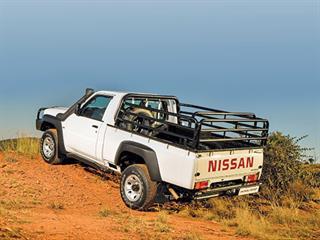
A few weeks ago, the Nissan Patrol 3-litre turbodiesel bakkie replaced the 4,2TD. This rugged pickup is a cut above the usual one-ton bakkie, and we jumped at the chance to drive one. The new engine, embodying the latest technology, develops 110kW instead of 90kW and offers 371Nm of torque instead of 282Nm. It can run on 500ppm high-sulphur diesel.
The bodywork is what you would expect from a workhorse. The grille has the now-traditional Nissan shape; the side panels are unadorned, and the tail-light clusters are generic off-the-shelf rectangular units instead of expensive proprietary units. The load area is rubberised, and one-piece steel wheels are fitted to show that this ain’t no city slicker.
The interior is plain and practical. The seats are cloth-covered, your feet rest on rubber mats, and a large covered compartment between the seats augments a very small glove box. The steering wheel has a limited tilt adjustment, and there are two airbags.
The Nissan Patrol accelerates very quickly up to 100km/h and cruises happily at freeway speeds. First gear is low, even
in high range, so that you can pull away quite successfully on the level in second gear. In fact, second and third are perfect for slow traffic. The steering is obviously power-assisted but not so much as to adversely affect steering feel.
No-nonsense suspension
Solid axles are fitted front and rear, the former coil-sprung, the latter leaf-sprung. This very simple and rugged system, the ultimate for a hard-working vehicle, ensures a consistent ground clearance underneath the axles when the wheels travel upwards
Over an obstacle
The disadvantage is a fairly harsh ride that affects passengers more than the driver. One glance at the rear wheels is further proof that this not your run-of-the-mill bakkie. A round plate secured by eight bolts in the centre of the hub shows that it has a fully floating rear axle. This type, universal on heavy trucks but never found on cars and seldom on bakkies, ensures that the axle shafts only have to transmit torque.
The vehicle’s mass and cornering loads, carried by the drive shafts in lesser bakkies, are transmitted directly from the wheel hub to the axle casing. The front wheels carry manually locking hubs. If a hub is locked, the drive shafts rotate with the wheels; if it is disengaged, only the wheel rotates. This means that the left and right hubs must both be engaged manually before selecting four-wheel drive.
The Patrol has the usual 4×4 bakkie choice of two-wheel or four-wheel drive in high or low (2,2:1 transfer ratio) range. Low range and two-wheel drive cannot be engaged at the same time.When engaged, a manual rear axle differential lock forces both rear wheels and one front wheel to rotate at the same speed due to a solid drive from the gearbox to the rear axle. This eliminates the need for a central differential lock between the front and rear axles.
Euro cycle fuel consumption is claimed to be 10,9l/100km. This standard normally gives consumption figures 20% more optimistic than what South Africans are likely to get. The Patrol has two fuel tanks of 95l and 80l respectively, with a switch on the dashboard for the smaller tank. The wheels are shod with Bridgestone Dueller H/T 70-profile tyres, labelled highway/all-season.
Replace them before contemplating any serious off-road work. The extra fuel tank at the rear has banished the spare wheel to just behind the cab on the side where it restricts rearward vision.
Not cheap, but worth it
The Patrol pickup, a no-nonsense and highly capable workhorse, costs R476 900. That’s a lot for a one-ton bakkie, but its two main rivals, the Toyota 70-series and the Land Rover Defender series, also cost more than R400 000. The Patrol comes with a three-year/100 000km warranty and requires service and oil change at 15 000km intervals.






